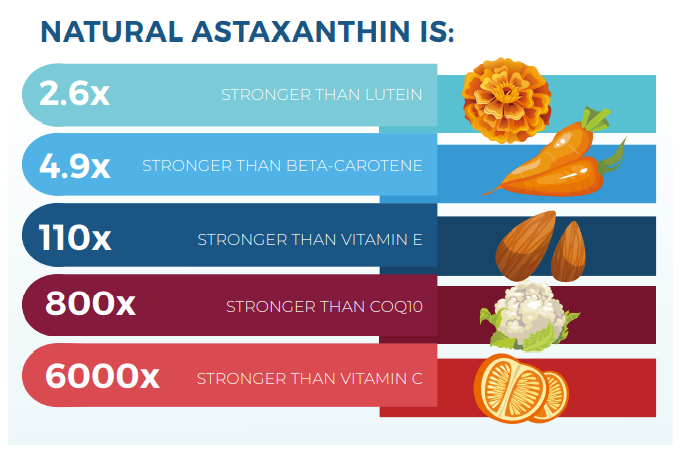Support canine health and aging with astaxanthin

As nature’s most powerful antioxidant, astaxanthin benefits canine endurance, aging, vision health and more.
Daily antioxidants are known to support canine health in a variety of beneficial ways. They promote a healthy immune response, support eye health in aging dogs, and contribute to a normal inflammatory response. Antioxidants also help neutralize potentially harmful free radicals.
Free radicals are reactive molecules produced both as by-products of the body’s natural physiology, and as a result of interaction with the environment. Antioxidants produced naturally by the body work together with dietary antioxidants to control and balance the level of free radicals in the body. When this balance is tipped in favor of free radical accumulation, oxidative stress and damage can occur to healthy cells. Oxidative stress can happen anywhere in the body, including in the muscles, eyes, skin, and brain.
Since all antioxidants work somewhat differently, a varied diet containing many is the most beneficial.

Astaxanthin, a natural antioxidant
Astaxanthin can boost a dog’s antioxidant capacity, helping to control oxidative stress. Natural astaxanthin is a targeted mitochondrial ingredient whose antioxidant activity is reported to be higher than that of beta carotene, lutein and vitamin E.

Natural astaxanthin is red in color and belongs to the family of antioxidants called carotenoids, which are most commonly found in fruits and vegetables. However, unlike carotenoids such as the beta-carotene found in carrots, lycopene found in tomatoes, and lutein found in spinach, natural astaxanthin is found in red-colored seafoods like lobster, crab, shrimp and salmon. For dogs and people, the main dietary source of natural astaxanthin is wild salmon. However, salmon is a rare protein in commercial dog food, and a dog would have to consume four filets of wild king salmon daily to get a beneficial amount of astaxanthin.
Natural astaxanthin has some features that make it unique among antioxidants:
- It is one of nature’s most powerful antioxidants, which means it is very good at quenching free radicals. One study revealed that astaxanthin is 6,000 times stronger than vitamin C, 110 times stronger than vitamin E, and even three to five times stronger than its cousin carotenoids, lutein and beta carotene.
- Astaxanthin is a fat-soluble antioxidant that can access cell membranes, unlike water-soluble antioxidants. This is important because cell membranes are made of lipids, which are especially sensitive to oxidation. Natural astaxanthin has a unique structure that can span the cell membrane from end to end for better membrane coverage and antioxidant protection.
- Though it favors all membranes, as much as 50% of all membrane-bound astaxanthin has been found in mitochondrial membranes, the energy-producing parts of the cell that also produce free radicals as a by-product of their metabolic activity. This means that natural astaxanthin is poised at the site of free radical production to help neutralize these unstable molecules before they start a chain reaction that can damage healthy mitochondria and tissue.



